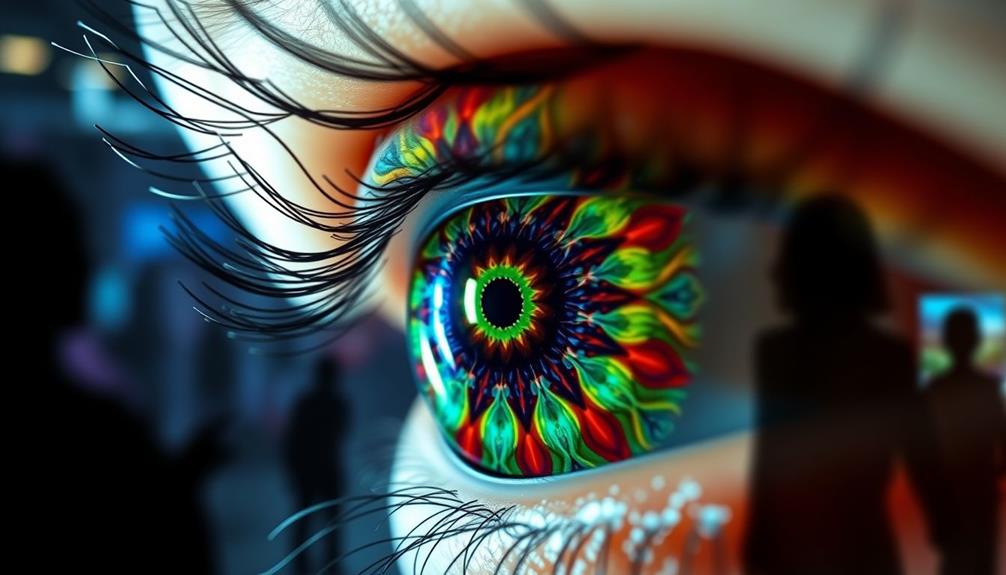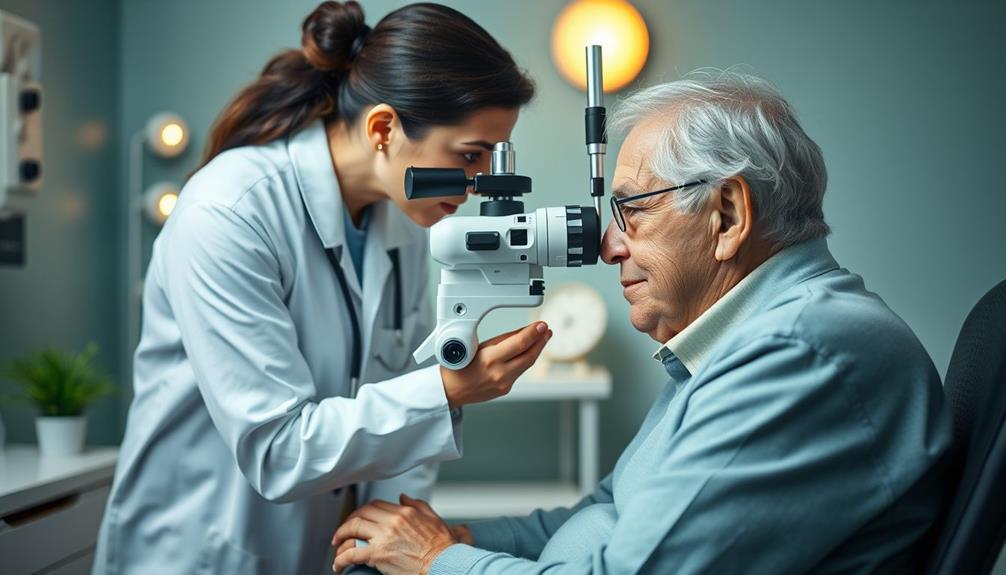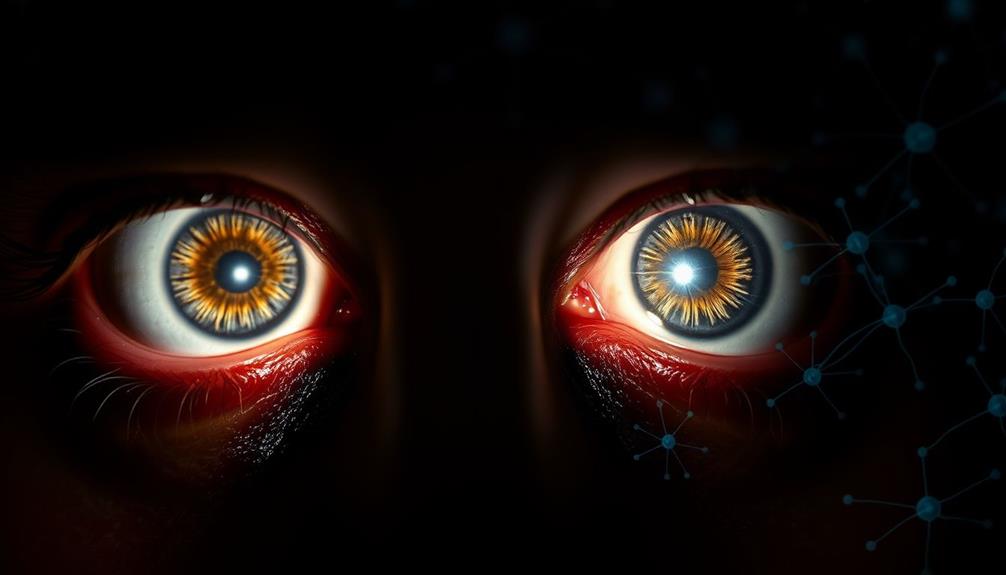If you have Parkinson’s disease, you may experience different vision problems such as dry eyes, double vision, and depth perception issues. These symptoms can significantly impact your daily life and increase the chances of accidents. It is important to have regular eye exams to address these challenges. Treatment options may include artificial tears for dryness, prism glasses for double vision, and proper lighting to improve depth perception. Maintaining open and effective communication with your healthcare provider can help tailor solutions that improve your quality of life. Being aware of these vision changes will empower you by providing you with the necessary tools for better management and support.
Key Takeaways
- Approximately 50% of individuals with Parkinson's experience vision problems, including dry eyes, double vision, and depth perception issues.
- Regular eye examinations are essential for early detection and management of vision changes; annual visits are recommended for those over 65.
- Treatment for dry eyes includes preservative-free artificial tears and warm compresses to alleviate discomfort and blurry vision.
- Double vision may be managed with prism glasses or eye patches, while good lighting can enhance depth perception and navigation safety.
- Communication with healthcare providers is crucial for exploring treatment options and adjusting plans based on ongoing symptoms.
Understanding Parkinson's Vision Changes

Experiencing vision changes is common for those with Parkinson's disease, and understanding these alterations is vital for managing daily life. One prevalent issue is dry eyes, affecting about 40% of individuals with Parkinson's. This happens due to decreased blinking, which can lead to discomfort and difficulties in focusing.
You might also face double vision, experienced by up to 30% of patients. This often stems from convergence insufficiency and can worsen after deep brain stimulation surgery, making it challenging to read or maintain visual attention. Additionally, factors such as medication interactions may exacerbate these symptoms, highlighting the significance of selecting appropriate treatments for related conditions like colds or allergies, where cold medications overview can play a role.
Additionally, visual hallucinations occur in approximately 50% of individuals with Parkinson's. These can be influenced by medication side effects and changes in visual function, which can be distressing.
You may notice eye movement issues, such as slowed saccadic movements, complicating reading tasks and making everyday activities frustrating.
Regular eye examinations are essential to monitor these changes. By understanding the potential vision issues related to Parkinson's, you can take proactive steps to manage your visual health. This awareness can greatly enhance your quality of life and help you navigate the challenges that come with Parkinson's disease.
Common Visual Symptoms in PD

If you have Parkinson's disease, you might face several common visual symptoms that can impact your daily life.
These symptoms may include challenges with visual processing and difficulty in focusing, which can exacerbate the discomfort caused by dry eyes.
Double vision may complicate tasks like reading or driving.
Additionally, issues with depth perception can increase your risk of falls, making it essential to address these challenges proactively.
Understanding the emotional dysregulation associated with conditions like BPD can also shed light on how visual symptoms might affect your overall well-being.
Dry Eyes Challenges
Many individuals with Parkinson's disease frequently face the challenge of dry eyes, a condition that arises from reduced blinking. This decrease in blinking can lead to discomfort, blurry vision, and increased light sensitivity, markedly impacting your daily activities.
Research shows that around 40% of those with Parkinson's experience visual symptoms, with dry eyes being a common complaint. Utilizing essential oils like eucalyptus oil may help improve overall comfort and promote respiratory health, which is beneficial for individuals managing multiple symptoms.
To manage dry eyes effectively, using preservative-free artificial tears is highly recommended. These artificial tears can provide the necessary moisture and relief you need throughout the day.
Regular eye examinations are also vital; they help monitor your eye health and address dry eye symptoms early, preventing further complications.
Additionally, engaging in an active lifestyle can promote better eye health. Regular physical activity not only enhances overall well-being but also encourages more frequent blinking, which can reduce dryness.
Double Vision Management
Up to 30% of individuals with Parkinson's disease encounter double vision, or diplopia, which can greatly disrupt daily activities. This condition often arises from eye alignment issues or convergence insufficiency, making it essential for you to address it promptly.
If you notice symptoms of double vision, don't hesitate to communicate them to your healthcare provider. They can help you explore potential treatment options, including medication adjustments or additional therapies. Early detection is vital, much like the importance of mammography for early detection in breast cancer.
One effective solution for managing double vision is the use of prism glasses. These glasses work by altering the light entering your eyes, helping to improve alignment and reduce the blurriness caused by diplopia.
In some cases, eye patches may serve as a temporary measure, particularly useful during activities like reading.
Regular eye examinations play a significant role in managing your vision. These check-ups allow your eye care professional to monitor changes in your condition and adjust your prescriptions as needed.
Depth Perception Issues
Double vision isn't the only visual symptom you might encounter with Parkinson's disease; depth perception issues can also greatly impact your daily life. These issues can make it difficult for you to understand spatial relationships, which can complicate navigation in your environment.
You may find it challenging to judge distances accurately, increasing your risk of falls and mobility-related accidents. Understanding your common financial terms can help you manage the costs associated with healthcare and support services.
Depth perception problems are often linked to slowed eye movements and convergence insufficiency, which are common in individuals with PD. As you navigate your surroundings, your ability to process visual information may be compromised, leading to further difficulties.
To help manage these challenges, consider enhancing your environment with good lighting and contrasting colors. These visual cues can improve your depth perception and make it easier to move safely through your space.
It's important to stay aware that around 50% of people with Parkinson's experience visual hallucinations, which can further complicate your spatial awareness. By recognizing these depth perception issues and implementing strategies to address them, you can enhance your safety and mobility in daily life.
Managing Vision Problems

Managing vision problems with Parkinson's disease is essential for maintaining your quality of life. Regular eye exams can help catch issues early, while specialized glasses and eye drops can greatly improve your visual comfort.
Additionally, staying informed about overall health management, including ultimate hamster care, can provide insights into maintaining a healthy lifestyle. By staying active and following these strategies, you can better navigate the challenges of vision changes associated with PD.
Common Vision Symptoms
Vision problems are a common yet often overlooked aspect of Parkinson's disease, affecting many individuals as the condition progresses. These issues can interfere with daily activities and overall quality of life, making it essential to recognize and address them early.
Here are some common vision symptoms you might encounter:
1. Dry Eyes: Caused by decreased blinking, dry eyes can lead to discomfort, blurred vision, and increased sensitivity to light. Using preservative-free artificial tears can help alleviate these symptoms.
Additionally, incorporating gentle stretching before bedtime can help relax the body and potentially ease some of the tension that may contribute to eye strain.
2. Double Vision: Up to 30% of people with Parkinson's experience double vision, often due to convergence insufficiency. This can be managed with tools like prism glasses or eye patches.
3. Depth Perception Issues: Impaired depth perception can make mobility challenging and increase your fall risk. Ensuring good lighting and using visual cues can enhance safety while guiding.
4. Regular Eye Exams: Keeping up with eye examinations is vital for early detection and management of vision changes, allowing for timely adjustments to your treatment plan.
Being aware of these symptoms can help you take proactive steps to manage your vision health while living with Parkinson's disease.
Treatment and Solutions
Addressing vision problems in Parkinson's disease requires a multifaceted approach tailored to your specific needs. For dry eyes, using preservative-free artificial tears and warm, moist compresses can greatly alleviate irritation and enhance comfort.
If you experience double vision, consider options like prism glasses or eye patches, and you might find it beneficial to have separate glasses for distance and reading instead of bifocals. Conducting regular background checks on your eye health is essential for early detection and management of these vision problems.
Regular eye examinations with an ophthalmologist are vital for early detection and management of these vision problems. They can help monitor your eye health and recommend appropriate treatments.
Additionally, botulinum toxin injections can effectively treat conditions like blepharospasm and apraxia of eyelid opening, reducing involuntary eyelid closure and improving your overall comfort.
Don't overlook the importance of collaborating with neuro-ophthalmologists. They specialize in eye movement issues and can optimize your treatment plan for visual disturbances related to Parkinson's.
Uncommon Vision Conditions

Many people with Parkinson's disease experience uncommon vision conditions that can greatly disrupt their daily lives. Two significant issues are blepharospasm and apraxia of eyelid opening.
Blepharospasm involves involuntary eyelid closure, making it challenging to see and engage in daily activities. Diagnosing the cause of such eyelid closure can be complex due to possible contributing factors like dry eyes or ptosis. Maintaining proper care and hygiene, much like with piercing care and hygiene, is important in managing these symptoms effectively.
Here are a few key points to reflect on regarding these uncommon vision conditions:
- Blepharospasm: This rare condition can severely affect your ability to function.
- Botulinum toxin injections: These injections can provide relief by reducing involuntary eyelid movements.
- Apraxia of eyelid opening: This condition makes it tough for you to open your eyes voluntarily.
- Lid crutches: These assistive devices can help manage apraxia by supporting eyelids.
Managing medications effectively is vital because some may worsen these symptoms. Regular consultations with your healthcare provider can help optimize treatment and improve your quality of life.
Addressing these uncommon vision conditions is essential for maintaining independence and comfort.
Importance of Regular Eye Care

Regular eye care is vital for anyone living with Parkinson's disease, as it helps identify and treat vision problems that can emerge due to the condition or its treatments.
It's important to recognize that individuals with Parkinson's may experience changes in their cognitive and emotional states, which can also impact their perception and response to visual stimuli; therefore, understanding the key domains of development in psychology can provide valuable insights into these challenges.
Regular eye exams are essential because they allow your eye care providers to detect vision issues early, which is particularly important given the increased risk of changes in vision as you age. The American Academy of Ophthalmology recommends annual eye examinations for individuals over 65, a guideline you should prioritize.
Engaging with eye care providers, including optometrists and neuro-ophthalmologists, guarantees you receive tailored treatment plans for Parkinson's-related vision problems.
These professionals can monitor your visual acuity, depth perception, and eye movement, helping prevent complications such as falls and fractures that may arise from impaired vision.
Non-Motor Symptoms and Vision

Vision problems are often overlooked as non-motor symptoms of Parkinson's disease, yet they can greatly impact daily life. Approximately 50% of individuals with Parkinson's experience visual problems, including blurry vision and dry eyes.
These issues are often exacerbated by decreased blinking and medication side effects. Convergence insufficiency, a common complaint, makes focusing on nearby objects challenging and can worsen after deep brain stimulation.
To help manage these non-motor symptoms, consider the following:
- Schedule regular eye examinations – This helps in early detection and management of visual problems.
- Stay hydrated – Drinking plenty of water can help alleviate dry eyes.
- Use artificial tears – These can provide relief from dryness and discomfort.
- Communicate with your healthcare team – Inform both your neurologist and eye care professional about any vision changes.
Resources for Patients and Caregivers

Access to reliable resources is essential for patients and caregivers steering through the challenges of Parkinson's disease. The Parkinson's Foundation offers a wealth of information and support specifically addressing vision issues related to this condition. One crucial resource is their helpline at 1-800-4PD-INFO, where you can get personalized assistance.
Additionally, it's important to maintain regular communication with your healthcare providers. Discuss any vision changes you notice, as they can recommend appropriate management strategies tailored to your needs. Engaging with community initiatives allows you to connect with others facing similar challenges, sharing experiences and insights.
Here's a quick overview of valuable resources:
| Resource Type | Description |
|---|---|
| Helpline | Call 1-800-4PD-INFO for immediate support |
| Educational Material | Access online resources about vision changes |
| Community Programs | Participate in shared experiences and learning |
| Multidisciplinary Care | Consult eye care professionals and neurologists |
Impact of PD on Eye Health

Parkinson's disease can profoundly affect eye health, leading to a range of visual challenges that may not be immediately obvious.
If you or someone you know has PD, it's vital to recognize these potential issues:
- Dry Eyes: Decreased blinking can lead to dry eyes, causing discomfort and blurred vision.
- Double Vision: Up to 30% of individuals with Parkinson's experience double vision, often due to convergence insufficiency or misaligned eye muscles.
- Visual Processing Issues: The loss of dopamine neurons can diminish color perception and overall visual clarity, making it harder to interpret what you see.
- Depth Perception Problems: Impaired spatial awareness complicates navigation, increasing the risk of falls.
Regular eye examinations are essential for managing these visual disturbances.
They can help monitor changes in vision and suggest strategies to cope with these challenges.
By being proactive about eye health, you can enhance your quality of life and maintain your independence.
Don't hesitate to reach out to an eye care professional for guidance on addressing these concerns related to Parkinson's disease.
Frequently Asked Questions
What Are the Symptoms of Stage 5 Parkinson's Disease?
In stage 5, you experience severe mobility issues, often needing a wheelchair. Basic movements become incredibly challenging, and you might face rigidity, bradykinesia, swallowing difficulties, speech impairments, and possible cognitive changes complicating your daily life.
What Should You Not Say to Someone With Parkinson's Disease?
When talking to someone with Parkinson's, avoid dismissive comments like "You don't look sick," or suggestions like "Just think positive." Respect their experiences, and focus on understanding their challenges rather than minimizing their feelings or struggles.
How Does Parkinson's Affect Your Vision?
Parkinson's can impact your vision in several ways. You might experience blurred vision, double vision, or difficulties focusing. These changes can affect daily tasks, making it essential to address any visual concerns with your healthcare provider.
What Is the Last Stage of Parkinson's Disease?
The last stage of Parkinson's involves severe motor difficulties, cognitive decline, and increased dependency on others. You may face significant challenges with movement, emotional struggles, and require full-time assistance for daily activities and personal care. In addition, during this advanced stage, sleep disorders in Parkinson’s, such as insomnia, REM sleep behavior disorder, and excessive daytime sleepiness, become more pronounced, further impacting your quality of life. Managing these symptoms often requires a multifaceted approach, including medication adjustments, specialized therapies, and caregiver support. Despite these challenges, maintaining regular medical care and a structured routine can help mitigate some difficulties associated with this stage.
Conclusion
So, if you thought Parkinson's disease only affected movement, think again! It's like a surprise party for your vision—only instead of confetti, you get blurred vision and double trouble. Remember, not every eye issue is a sign of aging; it could be your brain throwing a fit. Regular eye care is essential, so don't wait until you're mistaking your cat for a couch. Embrace the absurdity, because in this game of life, every detail counts—even the blurry ones!









